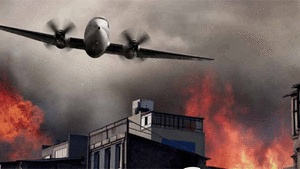I felt a little nervous as my plane landed at Omaha’s Eppley airport recently. Not because I was terrified of flying, but because I was afraid of flying into a body of water—one that hadn’t been there a month earlier.
This past summer has seen terrible flooding in the Midwestern US. While I had been hearing reports, I hadn’t actually comprehended the scale of this latest disaster—until my flight from Las Vegas began its descent into Omaha.
From my seat in the middle, I awkwardly leaned over the stranger sitting next to me and stared in disbelief at the newly formed wetland below. Farms had been turned into islands, highways and bridges were covered by the awesome flow of the river, and treetops peeked out from the depths. The runway levee itself was only metres from being breached. Thankfully, the concrete appeared and we landed safely. The flooding didn’t stop then. Other airports had to help Omaha with their rerouted flights. Highways were closed at various points.
Somehow, I am not as panicked as I should be. After all, this disaster is simply the latest in a barrage of heartbreaking, devastating events that are making humanity miserable.
Joplin, Missouri, was blown off the face of the earth by a tornado, and a whole swarm of twisters ransacked the South not too long ago. In recent years, earthquakes have rearranged the surfaces of Chile and Christchurch, and a huge tsunami washed over some of the coastal areas of Japan. Who knows what will come next? My family is preparing to move to Washington State, the home of an active volcano called Mount Rainier. We joke, with a slight tinge of seriousness, that it will blow as soon as we arrive.
A lot of people are considering that the end of the world may be approaching. Hollywood produces movies like 2012, based on the fear that when the Mayan calendar runs out, all will be over. And people like Harold Camping keep coming up with new and improved dates for the end of the world.
What the Bible says
In the Gospel of Matthew, Jesus made some predictions and commentary on what will happen just before He returns and makes the world new.
After His disciples asked Him what sort of things to look for as indications that the world is about to end, He replied, “You will hear of wars and rumours of wars, but see to it that you are not alarmed. Such things must happen, but the end is still to come. Nation will rise against nation, and kingdom against kingdom. There will be famines and earthquakes in various places. All these are the beginning of birth pains” (Matthew 24:6–8).
The good news is that while all these disasters are signs of the end of the world, they are only “the beginning of [the world’s] birth pains.” I’m sure every mother you know could tell you just how long birth pains can last—and how bad they can be.
Which leads to the bad news: we may be only at the tip of the iceberg on our way to the end! Not only that, but people will protest, “Haven’t we always had these kinds of disasters?”
Doomsdayers will spend time trying to prove that the frequency and intensity of these horrors have increased over the years. While this may be true, most of the time I’m not convinced on their methods of proving such a thing. After all, we now have better equipment to measure things than anyone did in ancient times. And that said, nevertheless, I do believe that time is indeed short.
A global village
Jesus said that we would “hear of wars and rumours of wars.” In ancient times, no-one had the internet, GPS, radio or television. In some cases you might have heard of a war about the time it was over.
Today, we can hear just about anything about anyone in the world, and so often it is not good news. We hear of rumours more quickly and accurately than at any other time in history, and there’s more. While the types of natural disasters haven’t changed—either in substance or maybe even in frequency—their effect certainly has.
Never before has the world been so interconnected in communications, economies, governments and natural resources. Never before have the citizens of our planet been this closely intertwined. This means that when one part of the world is ravaged, other parts are affected. It is no longer “somebody else’s problem,” it’s all “our problem.”
And even if our particular part of the world is unscathed, the news media flood us with so many images of the suffering that unless we completely lack a moral compass, we often feel compelled to act and help relieve the hurting.
As the world creaks under natural disasters and as wicked people make it their life’s mission to take the lives of others, Jesus’ words are haunting as He continues by saying, “Because of the increase of wickedness, the love of most will grow cold” (Matthew 24:12).
Perhaps it’s from outrage at all the injustice, indifference and callousness from simply being surrounded by sin, but people are growing more stressed, angry and frustrated with life. That’s why Jesus admonishes us to “stand firm” until the end, because salvation is coming.
The good news
While our interconnectedness means worse effects of painful experiences, it also opens the door to communicate hope and salvation.
Jesus says, “And this gospel of the kingdom will be preached in the whole world as a testimony to all nations, and then the end will come” (Matthew 24:14).
We have a chance, through all the media of the day, to communicate hope and to put a little twist on what most people think of when they hear about the “end of the world.” Jesus mentions all the atrocities that will pummel the planet and then He says, “The end is not yet.”
While it’s certainly true that these atrocities are terrible, the end of the world as we know it is not yet here. So what is “the world as we know it”?
Based on Jesus’ description, and no doubt our own experience, this world is broken, dangerous, unpredictable, tragic, violent and beautiful, but also severely flawed. So “the end” to me isn’t the scary part; it’s the end of all the scary parts. The end of the world isn’t the mess; it’s about being rescued from the mess.
I don’t know how long we have until the world ends, but I do know that for those who believe in Jesus, it isn’t something to be scared of. The good news about the end of time is that it will be the end of pain, suffering and unanswered questions. The end of the world will mark the beginning of Jesus’ reign. And His reign will begin with a glorious bang!
Paul described it this way: “For the Lord himself will come down from heaven, with a loud command, with the voice of the archangel and with the trumpet call of God, and the dead in Christ will rise first. After that, we who are still alive and are left will be caught up together with them in the clouds to meet the Lord in the air. And so we will be with the Lord forever. Therefore encourage each other with these words” (1 Thessalonians 4:16–18).
The Bible tells us to encourage each other with thoughts about the end of the world, which is not exactly the message Hollywood preaches. So whenever you find yourself marvelling at how the world seems to be degenerating and growing darker, know that the Light is coming. And He is coming soon.





